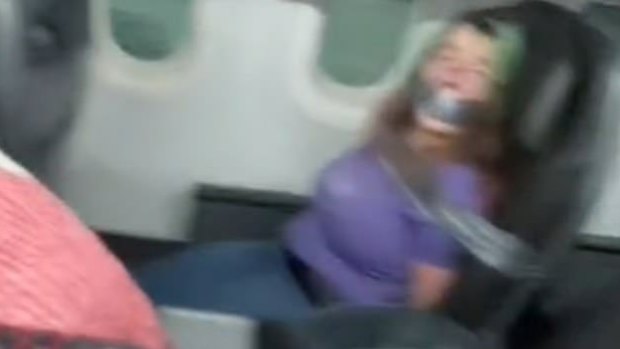This was published 3 years ago
Passengers duct-taped on planes: Flight attendants use tape more often than you think
By Hannah Sampson

A video posted on TikTok last month showed a woman duct-taped to her seat on an American Airlines flight.
When flight attendants used duct tape to keep an unruly woman in her seat during an American Airlines flight last month, the solution seemed surprising to many.
Then it happened again weeks later, when tape was used to restrain a man who allegedly groped and punched flight attendants on a Frontier Airlines flight. Even more recently, passenger video on a plane showed an American Airlines cabin crew member with duct tape during an incident with a young passenger, though restraint cuffs were ultimately used.
Turns out, it has been happening for years: News reports include examples involving a United Airlines passenger in 2003, a woman on United in 2008, a man on Icelandair in 2013 and a woman on American in 2018.

Maxwell Berry was duct-taped to his seat on a Frontier Airlines flight and later charged with three counts of misdemeanor battery for allegedly assaulting flight attendants.Credit: AP and Supplied
"It's common to use duct tape to secure a person who represents a threat to the flight or others," Jeff Price, professor of aviation management at Metropolitan State University of Denver, told The Washington Post earlier this month in a message.
Airline policies differ, and the Federal Aviation Administration gives crew members some flexibility in dealing with disruptive passengers.
"The flight crew is responsible for cabin safety and has latitude on how to handle individual situations," the agency said in a statement.
The International Air Transport Association said in a statement that passengers are only ever restrained as a last result if other efforts to get a situation under control have not worked.
"Cabin crew are trained in de-escalation and restraint techniques and equipment (if carried) by their airline," the statement said. "There is no industry standard restraint equipment, so it is up to the individual airline. Some airlines may equip their cabins with kits that include restraint devices."
American Airlines, for example, includes restraint cuffs and tape in kits for flight attendants. The airline's policy says flight attendants should try to de-escalate a situation before turning to restraints, and those are used with agreement from the captain if needed to keep a passenger from hurting themselves or others.
The policy at Delta Air Lines does not allow passengers to be restrained to the plane because it could get in the way of evacuation if necessary. The airline doesn't provide duct tape to crews, but crew can use restraint cuffs if de-escalation tactics don't work and a passenger is a threat.
"Paired with our processes and systems, our flight attendants are empowered to use their judgment to ensure a safe environment for all," the airline said in a statement. "Our Delta teams are trained and prepared to handle these situations and do a phenomenal job doing so."
United, Southwest, JetBlue and Frontier either declined to provide policies on restraints or did not respond to questions.
The Association of Flight Attendants-CWA said Frontier provides tape for crew. After the recent case on a Miami-bound Frontier flight, the airline said it put the flight attendants on paid leave, "in line with an event of this nature pending an investigation."
The outcome of that investigation was not clear Friday.
"I really don't know how you would mitigate a security threat in the air other than to hit the guy in the head really hard, or, more reasonable, use duct tape, rope or flex cuffs," Price, the aviation professor, told The Washington Post.
Recent uses of duct tape come amid an unprecedented increase in disruptive passenger behaviour this year, including altercations where members of the flying public assaulted flight attendants and each other. The FAA said earlier this week that it had received 3,810 reports of unruly passengers and kicked off 655 investigations since the beginning of the year.
Thomas Anthony, director of the University of Southern California's Aviation Safety and Security Program, said it is a "significant safety compromise to the crew and to the safety of the aircraft" if crew members are assaulted, intimidated or threatened.
Anthony said airlines, federal authorities and unions should work together to come up with common procedures for dealing with interference of a flight crew that are accepted by all airlines. He said any such work group should establish that crew use the minimum amount of restraint to keep order and safety on the plane, and that restraint should be a last resort in a progression of measures.
"In certain circumstances, duct tape may be appropriate ... for the protection of everybody, not only the person who's causing the commotion, but the people on board and the flight crew," he said.
The Washington Post
Sign up for the Traveller newsletter
The latest travel news, tips and inspiration delivered to your inbox. Sign up now.